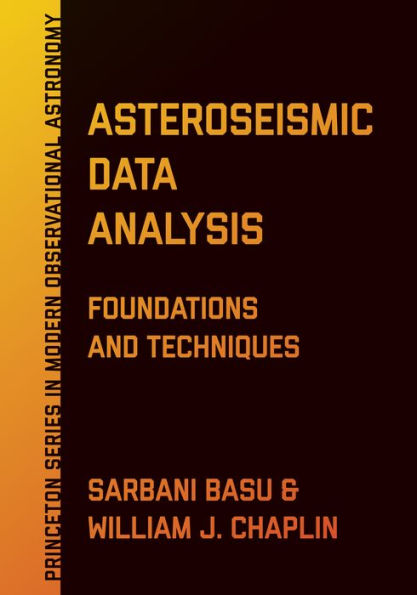Asteroseismic Data Analysis: Foundations and Techniques
Studies of stars and stellar populations, and the discovery and characterization of exoplanets, are being revolutionized by new satellite and telescope observations of unprecedented quality and scope. Some of the most significant advances have been in the field of asteroseismology, the study of stars by observation of their oscillations. Asteroseismic Data Analysis gives a comprehensive technical introduction to this discipline. This book not only helps students and researchers learn about asteroseismology; it also serves as an essential instruction manual for those entering the field.
The book presents readers with the foundational techniques used in the analysis and interpretation of asteroseismic data on cool stars that show solar-like oscillations. The techniques have been refined, and in some cases developed, to analyze asteroseismic data collected by the NASA Kepler mission. Topics range from the analysis of time-series observations to extract seismic data for stars to the use of those data to determine global and internal properties of the stars. Reading lists and problem sets are provided, and data necessary for the problem sets are available online.
The first book to describe in detail the different techniques used to analyze the data on stellar oscillations, Asteroseismic Data Analysis offers an invaluable window into the hearts of stars.
1125843979
The book presents readers with the foundational techniques used in the analysis and interpretation of asteroseismic data on cool stars that show solar-like oscillations. The techniques have been refined, and in some cases developed, to analyze asteroseismic data collected by the NASA Kepler mission. Topics range from the analysis of time-series observations to extract seismic data for stars to the use of those data to determine global and internal properties of the stars. Reading lists and problem sets are provided, and data necessary for the problem sets are available online.
The first book to describe in detail the different techniques used to analyze the data on stellar oscillations, Asteroseismic Data Analysis offers an invaluable window into the hearts of stars.
- Introduces the asteroseismic study of stars and the theory of stellar oscillations
- Describes the analysis of observational (time-domain) data
- Examines how seismic parameters are extracted from observations
- Explores how stellar properties are determined from seismic data
- Looks at the “inverse problem,” where frequencies are used to infer internal structures of stars
Asteroseismic Data Analysis: Foundations and Techniques
Studies of stars and stellar populations, and the discovery and characterization of exoplanets, are being revolutionized by new satellite and telescope observations of unprecedented quality and scope. Some of the most significant advances have been in the field of asteroseismology, the study of stars by observation of their oscillations. Asteroseismic Data Analysis gives a comprehensive technical introduction to this discipline. This book not only helps students and researchers learn about asteroseismology; it also serves as an essential instruction manual for those entering the field.
The book presents readers with the foundational techniques used in the analysis and interpretation of asteroseismic data on cool stars that show solar-like oscillations. The techniques have been refined, and in some cases developed, to analyze asteroseismic data collected by the NASA Kepler mission. Topics range from the analysis of time-series observations to extract seismic data for stars to the use of those data to determine global and internal properties of the stars. Reading lists and problem sets are provided, and data necessary for the problem sets are available online.
The first book to describe in detail the different techniques used to analyze the data on stellar oscillations, Asteroseismic Data Analysis offers an invaluable window into the hearts of stars.
The book presents readers with the foundational techniques used in the analysis and interpretation of asteroseismic data on cool stars that show solar-like oscillations. The techniques have been refined, and in some cases developed, to analyze asteroseismic data collected by the NASA Kepler mission. Topics range from the analysis of time-series observations to extract seismic data for stars to the use of those data to determine global and internal properties of the stars. Reading lists and problem sets are provided, and data necessary for the problem sets are available online.
The first book to describe in detail the different techniques used to analyze the data on stellar oscillations, Asteroseismic Data Analysis offers an invaluable window into the hearts of stars.
- Introduces the asteroseismic study of stars and the theory of stellar oscillations
- Describes the analysis of observational (time-domain) data
- Examines how seismic parameters are extracted from observations
- Explores how stellar properties are determined from seismic data
- Looks at the “inverse problem,” where frequencies are used to infer internal structures of stars
93.0
In Stock
5
1

Asteroseismic Data Analysis: Foundations and Techniques
352
Asteroseismic Data Analysis: Foundations and Techniques
352Hardcover
$93.00
93.0
In Stock

Product Details
| ISBN-13: | 9780691162928 |
|---|---|
| Publisher: | Princeton University Press |
| Publication date: | 09/05/2017 |
| Series: | Princeton Series in Modern Observational Astronomy , #4 |
| Pages: | 352 |
| Product dimensions: | 7.00(w) x 10.10(h) x 1.10(d) |
About the Author
What People are Saying About This
From the B&N Reads Blog
